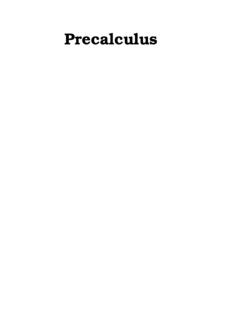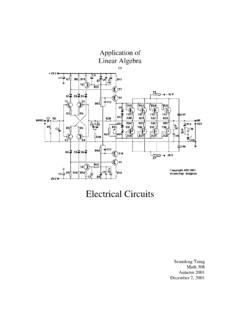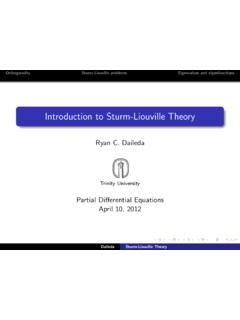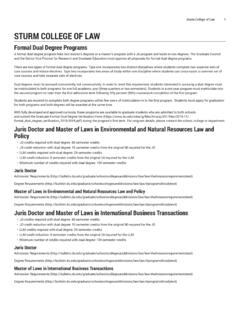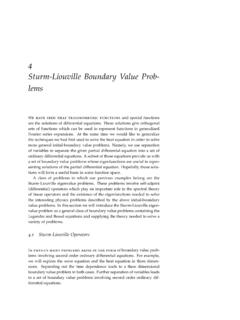Transcription of STURM-LIOUVILLE BOUNDARY VALUE PROBLEMS
1 STURM-LIOUVILLE BOUNDARY VALUE PROBLEMST hroughout, we let [a,b] be a bounded interval ([a,b]) denotesthe space of functions with derivatives of second order continuous up tothe ([a,b]) is the subspace of functions that vanish near a second order differential operator of the formLu(x) =r(x)u (x) +r (x)u (x) +q(x)u(x)=ddx(r(x)dudx)+q(x)u(x).(1)We assume thatr C1([a,b]) andq C0([a,b]) are real, and thatr(x) cfor somec > operatorLis the most general second order real ODE which isformallyself-adjointonL2(dx), in that ba(Lu)v dx= bau(Lv)dx u,v C2c([a,b]).The conditionu,v C2c([a,b]) implies that when integrating by parts theboundary terms vanish. SinceLhas real coefficients, conjugatingvor notdoes not affect the generalu,v C2([a,b]),(2) ba(Lu)v u(Lv)dx=r(u v uv ) baand we need to impose first order conditions onu,vat the endpoints tomake the right hand side conditionBis an expression of the formBu= u(a) + u(b) + u (a) + u (b)for real constants.
2 We will impose two conditionsB1u= 0 andB2u= 0 whereB1andB2are independent ( the corresponding vectors( , , , ) are independent), chosen to guarantee that the right hand sideof (2) BOUNDARY conditionsB1, B2are self-adjoint forLif, forallu,v C2([a,b]) which satisfyB1u=B2u=B1v=B2v= 0, then ba(Lu)v dx= bau(Lv) other words, the vanishing ofBjuandBjvimplies the right-hand side of(2) LECTURE NOTES Dirichlet conditions:B1u=u(a), B2u=u(b). Neumann conditions:B1u=u (a), B2u=u (b). Robin conditions:B1u=u (a) u(a), B2u=u (b) + u(b), , > above areseparated BOUNDARY conditions, in thatB1is a condition ataandB2is a condition atb. Any pair of separated conditions is self-adjointfor generalL. The most common non-separated condition is Periodic conditions:B1u=u(b) u(a), B2u=u (b) u (a).
3 These are self-adjoint forLifr(b) =r(a). Another way to state self-adjointness is to consider the subspaceC2B([a,b]) ={u C2([a,b]) :B1u=B2u= 0}.Then (L,B1,B2) is self-adjoint provided that Lu,v = u,Lv foru,v C2B([a,b]), where u,v = bau v next fix a positive weight function (x) C2([a,b]), so (x) c >0 forx [a,b], and consider theSturm- liouville eigenvalue problemLu= u, B1u=B2u= say that the number is an eigenvalue if there is a nonzero solutionu C2([a,b]) to this equation, and calluan (L,B1,B2, )be a self-adjoint STURM-LIOUVILLE associated eigenvalues are all real associated to different eigenvalues are orthogonal inthe inner product u,v = bau(x) v(x) (x) dimension of each eigenspace is at most 2; if the BOUNDARY con-ditions are separated then it is exactly that an eigenfunctionuis an eigenvector for the operator 1L, 1Lu= u, and that 1Lu,v = u, 1Lv , so that 1 Lis self-adjoint on the domainC2B([a,b]) with respect to the inner product.
4 The proof of a and b then follow exactly as for finite dimensional c, we note that the space of solutions to (L )u= 0 is a 2-dimensionalsubspace ofC2([a,b]). If one imposes a separated conditionB1u= 0, thisrestricts the initial conditions(u(a),u (a))to a 1-dimensional space, hencethere is at most a 1-dimensional space of solutions to (L )u= 0 withthe BOUNDARY conditions imposed. Theorem a self-adjoint STURM-LIOUVILLE system as above, there isan orthonormal basis for the spaceL2 ([a,b])consisting of eigenfunctions forthe STURM-LIOUVILLE problem . The eigenvalues satisfy n .526/556 LECTURE NOTES3 Here,L2 ([a,b]) is the space of measurableuon [a,b] such that u 2L2 = ba|u(x)|2 (x)dx < .Since (x) is bounded above and below, this is the same space of functionsasL2([a,b]), but the norm and inner product , are different.
5 The mapu 12uis easily seen to be a unitary map ofL2 ontoL2: 12u L2= u L2 .In particular,{uj} j=1is an orthonormal basis forL2 iff{ 12uj} j=1is anorthonormal basis will prove Theorem 3 in the case of separated BOUNDARY conditions forsimplicity, but it holds for general self-adjoint BOUNDARY conditions. Westart the proof by reducing to the case where = 1. Consider the operator Lu= 12L( 12u) =ddx(r dudx)+ qu, q= 12L( 12),which is formally self-adjoint onL2(dx), andLu= uiff L( 12u) = also define BOUNDARY conditions Bj(u) =Bj( 12u); it follows easily that B1, B2are self-adjoint for conclude there is orthonormal basis forL2( dx) of eigenfunctions for 1 LsatisfyingBjiff there is an orthonormal basis forL2(dx) consisting ofeigenfunctions for Lsatisfying Bj, where the bases are related by multiplyingby thus assume = 1, and consider the eigenfunction problemLu= u,whereLu= (ru ) +qu, and we impose self-adjoint conditionsB1u=B2u= is an eigenvalue forLu= u, then Cfor some constantCdepending on(L,B1,B2).
6 By parts we have ba|u|2dx= ba(Lu) udx= ba r|u |2+q|u|2dx+r(x)u(x)u (x) x=bx= Dirichlet or Neumann conditions, the BOUNDARY terms vanish, and(3) ba|u|2dx baq|u|2dx (max[a,b]q) ba|u| Robin conditionsu (a) = u(a),u (b) = u(b), we get ba|u|2dx= ba r|u|2+q|u|2dx r(a)|u(a)|2 r(b)|u(b)| LECTURE NOTESIn the physically realistic case , 0, then (3) still applies. If one or bothis negative, we need more work. We boundmax[a,b]u2 min[a,b]u2 ba ddxu2 dx= 2 ba|u ||u|dx ba|u |2+ 2 1 ba|u| small, forC sufficiently large we have| |r(a)|u(a)|2+| |r(b)|u(b)|2 bar|u |2+C ba|u|2dxand then ba|u|2dx ba(q+C )|u|2dx (C + max[a,b]q) ba|u|2dx. We replaceLbyL 0with 0= 1 +C, which has the same eigenfunctions,but with eigenvalues shifted by 0. We may thus assume all eigenvaluessatisfy 1, and in particular(4)Lu= 0, B1u=B2u= 0,impliesu= produce eigenfunctions forLby finding eigenfunctions for the operatorL 1, which we express as an integral kernel.
7 Thus, we seek to express thesolution toLu=f , B1u=B2u= 0,wheref C([a,b]),in the form(5)u(x) = baG(x,y)f(y)dy .The functionG(x,y) is calledGreen s kernelfor the problem (L,B1,B2). Wewill apply variation of parameters: letu1andu2be nonzero real solutionstoLu1=Lu2= 0, B1u1= 0, B2u2= separated, thenu1andu2are determined up to a con-stant multiple. Furthermore,u1andu2are linearly independent; otherwisethey are both solutions to (4). ThusW(x) = det[u1(x)u2(x)u 1(x)u 2(x)]6= Abel s theorem,rW +r W= 0, sorW= constant. The variation ofparameters method states that if[u1(x)u2(x)u 1(x)u 2(x)][c 1(x)c 2(x)]=[0f/r]526/556 LECTURE NOTES5thenu=c1u1+c2u2solvesLu=f. This has solutionc 1= u2frW, c 2= a first order operator ata, thenB1u=c1(a)B1u1+c2(a)B1u2,and this vanishes ifc2(a) = 0.
8 SimilarlyB2u= 0 ifc1(b) = 0. Thus we setc1(x) = bxu2(y)rWf(y)dy , c2(x) = xau1(y)rWf(y)dy .Then (5) holds, whereG(x,y) ={(rW) 1u1(x)u2(y), y x,(rW) 1u2(x)u1(y), x y .Note thatG(x,y) =G(y,x), and thatG(x,y) is continuous on [a,b] [a,b].Furthermore,Gis real sinceu1andu2are. The kernelGis also a left inverseforL, in that ifv C2B([a,b]), thenv(x) = baG(x,y) (Lv)(y)dy .This follows by uniqueness of solutions (4). In particular, if one considersthe mapsL:C2B([a,b]) C([a,b]), G:C([a,b]) C2B([a,b]),then these maps are respectively the inverse of each other. It follows thatGis 1-1 on the space of continuous functions, but we need a stronger resultfor the diagonalization thatf L2([a,b]), and that baG(x,y)f(y)dy= 0forallx. Thenf(y) = will show that f(y) (y)dy= 0 for all C2c([a,b]), and theresult follows by density ofC2cinL2.}
9 We then write baf(y) (y)dy= baf(y)( baG(y,x) (L )(x)dx)dy= ba( baG(x,y)f(y)dy)(L )(x)dxusing Fubini s theorem. The operatorTf(x) = baG(x,y)f(y)dyis then a self-adjoint, compact op-erator onL2([a,b]), and 0 is not an eigenvalue ofT. There thus exists anorthonormal basis{uj} j=1forL2([a,b]), where baG(x,y)uj(y)dy= juj(x), j6= the left hand side is continuous inxso isuj(x), and thus the left handside belongs toC2B([a,b]), and souj C2B([a,b]). We then haveLuj= juj, j= 1j,6526/556 LECTURE NOTESand by Lemma 2 each eigenspace is 1-dimensional (separated BOUNDARY con-ditions). We have arranged that j 1, which means we can order themso that j in a decreasing manner. The eigenvalues for the originalproblem are j+ 0, which still decrease to , but there may be finitelymany positive eigenvalues, depending onqand the BOUNDARY conditions.

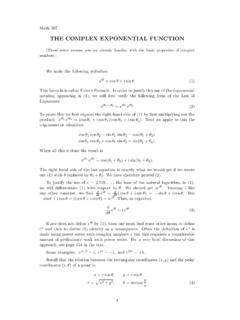

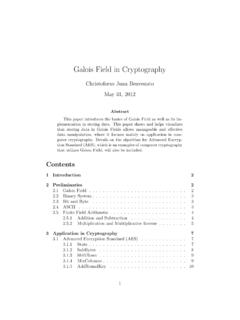
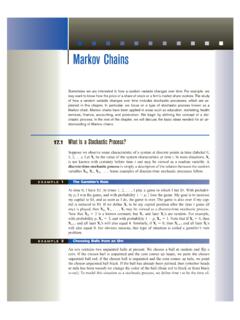
![ZZ dA R [0 2] R - University of Washington](/cache/preview/6/4/c/c/9/f/d/6/thumb-64cc9fd6ac93e2995c04a2a74b217176.jpg)
